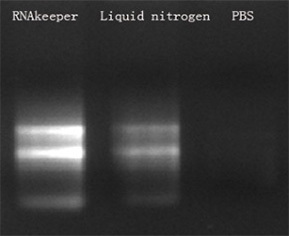Product Introduction
Product name:RNAkeeper
Cat:PVB-3004 (100mL)
PVB-3005 (500ml)
Storage Conditions: Store at room temperature. Valid for 12 months. If precipitation occurs, place the solution at 37℃ until the precipitate dissolves, it can be used normally then.
Product Description
RNAkeeper is a liquid, non-toxic tissue preservation solution. It can rapidly penetrate into tissue cells and protect and stabilize the RNA within them. It ensures that the quantity and quality of RNA in tissue cells not preserved at ultra-low temperatures are fully protected. RNAkeeper can reduce the need to immediately place tissue samples in liquid nitrogen for RNA preservation after acquisition (see Figures 1 and 2). RNAkeeper can be widely applied to various animal tissue samples, such as brain, heart, liver, lung, kidney, spleen, fat, muscle, and glands. RNAkeeper is also effective for fruit fly and some plant tissues. RNAkeeper is compatible with most RNA extraction reagents, such as TRI Reagent and RNAqueous, etc.

Figure 1 shows the results of RNA electrophoresis after extraction from mouse spleen tissues that were:
Stored in RNAkeeper at 4℃ for 4 weeks (Figure 1, left),
Immediately placed in liquid nitrogen after dissection (Figure 1, middle),
Stored in PBS at 4℃ for 4 weeks (Figure 1, right).

Figure 2 shows the results of RNA electrophoresis after extraction from mouse spleen tissues that were:
Stored in RNAkeeper at room temperature for 2 weeks (Figure 2, left),
Immediately placed in liquid nitrogen after dissection (Figure 2, middle),
Stored in PBS at room temperature for 2 weeks (Figure 2, right).
Method of application
Tissue Blocks:
RNAkeepe is only applicable to fresh tissues. There is no need to freeze the tissue before immersing it in RNAkeeper. Cut the tissue block to a thickness of less than or equal to 0.5 cm, and then place the tissue into five times its volume of RNAkeeper for storage. RNAkeeper will not dissolve or destroy the structural integrity of the tissue sample. If necessary, tissue that has been immersed in RNAkeeper can be sectioned, and then re-immersed in RNAkeeper. Small organs, such as mouse liver, kidneys, and spleen, can be preserved intact in RNAkeeper (see “Sample Preservation Time in the Preservation Solution” for details).
Plant Tissues:
It is necessary to disrupt their natural barriers that prevent diffusion, such as the waxy cuticle of leaf tissues, to allow RNAkeeper to penetrate into the tissue cells (see “Sample Preservation Time in the Preservation Solution” for details).
The storage time of the sample in the storage solution
Store at -80℃
This method is recommended for the processing of long-term stored samples. The sample is soaked in a sufficient amount (at least five times the volume) of RNAkeeper, incubated at 4 ° C overnight, then removed from the RNAkeeper tissue preservation solution and stored at -80 ° C. Samples can be thawed and refrozen at room temperature in subsequent operations without affecting the quality and quantity of RNA.
Store at -20℃
This method is recommended for the processing of samples intended for long-term preservation. Immerse the sample in an adequate volume of RNAkeeper, and incubate it overnight at 4°C. After incubation, transfer the sample directly to -20°C. At -20°C, RNAkeeper will not solidify, but crystallization may occur. This does not affect subsequent RNA extraction. The sample can be thawed and refrozen at room temperature during subsequent operations without compromising the quality and quantity of RNA.
Store at 4℃ and at room temperature
The sample can be preserved in RNAkeeper at 4°C for one month without RNA degradation.
Experiments have shown that the sample can be preserved in RNAkeeper for two weeks without RNA degradation.
RNA extraction from samples in storage solution
Using sterilized forceps, remove the sample from the RNAkeeper and transfer it into the RNA extraction solution, followed by rapid homogenization.








